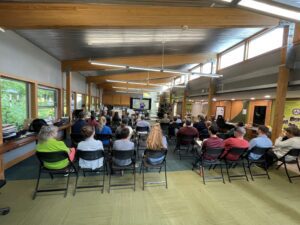June Monthly Meeting Recap:
Our 2023 June Monthly Meeting was held on the 2nd at 7:30 a.m. at the Watershed Center
Eric Fuselier, an environmental scientist specializing in plant selection, presented “The Importance of Species Selection for Improving Stormwater Quality with Native Plants.”
Mr. Fuselier explained that stormwater runoff from impervious surfaces oftentimes carries pollutants into local waterways and creates ‘flashy flows.’ If untreated, runoff often causes streambank erosion which leads to murky water, carries pollutants that affect water quality and delicate stream life, and can affect drinking water supplies. He said the Three S’s of stormwater management techniques are Soak it Up, Spread it Out, and Slow it Down, and this can be done with the help of native plants. Low Impact Development techniques include:
Low Impact Development techniques include:
- rain gardens
- bioswales
- grass swales, vegetated swales, wet swales
- dry and wet detention ponds
- filter strips
- green roofs
Native plants in these areas help filter contaminants with their extensive root systems. They also help support the local food web. Mr. Fuselier said using native plants is helping to “reweave the web of life” by bringing back some of the habitats that have been lost to urban development.
Fuesiler said native plants help break down pollutants by a process called phytodegradation that allows them to incorporate the nutrients into the plant tissues and use them as “food.” They also break down contaminants in the soil through the microbial activity that is enhanced by the presence of the rhizosphere called Phytosimulation.
Some of the best native plants to use in these areas are Big Blue Stem Little Blue Stem, Switch Grass, Indian Grass, Honey Locust, Side Oats Gramma, Eastern Gama Grass, Common Rush, Elm Leaf Goldenrod, Arrowhead, Black Willow, Sandbar Willow.
Examples of these stormwater management techniques being used successfully in Arkansas include the Van Buren Golf Course, Hickory Creek Marina at Beaver Lake, Osage Park in Bentonville, Thunder Chicken Trailhead, Lake Atlanta in Rogers, and the Blue Cross Blue Shield Office in Springdale. Mr. Fuselier works at the Olsson office in Fayetteville, Arkansas, and can be reached by email: [email protected]. 
National Weather Service Update
Megan Terry with the National Weather Service gave a presentation of Spring Weather Highlights that included precipitation, storm events, drought, climate outlook, flood inundation mapping, and safety outreach.
 Ms. Terry said precipitation in Springfield for the year is around normal at 20 inches. However, other areas in Southwest Missouri have departures from normal as much as 8 inches less and twelve inches more. She reported a storm event on March 23-24 that included strong wind gusts, dumping 5-6 inches of rain in the area in a five-hour period, and another rain event on April 14th with very large hail. Next, she showed the latest drought monitor of the area, and Greene County was currently in no drought!
Ms. Terry said precipitation in Springfield for the year is around normal at 20 inches. However, other areas in Southwest Missouri have departures from normal as much as 8 inches less and twelve inches more. She reported a storm event on March 23-24 that included strong wind gusts, dumping 5-6 inches of rain in the area in a five-hour period, and another rain event on April 14th with very large hail. Next, she showed the latest drought monitor of the area, and Greene County was currently in no drought!
Precipitation for the next seven days should average a half inch with near-normal temperatures. The climate outlook for June-August shows just above-normal chances of precipitation and normal temperatures. A Flood Inundation Mapping Tool for the nation will be live in 2024. NWS Safety Outreach campaigns include heat, hurricane, floods, and lightning.
Regional Updates
Todd Wilkinson with James River Basin Partnership said registration is open online for the River Rescue Saturday, June 10. Christy Wilder said more Watershed Natives Plants and Pints sales are on, including June 16 at 4×4 Brewing in Fremont Hills. See further event details on our Facebook page!

